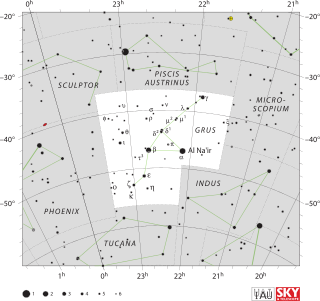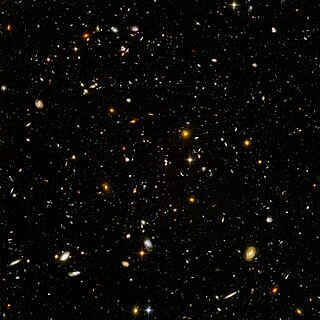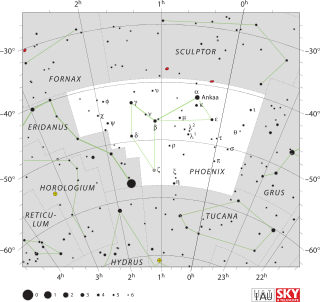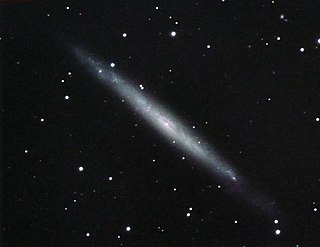Related Research Articles

The Big Bang is a physical theory that describes how the universe expanded from an initial state of high density and temperature. The notion of an expanding universe was first scientifically originated by physicist Alexander Friedmann in 1922 with the mathematical derivation of the Friedmann equations.

A galaxy is a system of stars, stellar remnants, interstellar gas, dust, and dark matter bound together by gravity. The word is derived from the Greek galaxias (γαλαξίας), literally 'milky', a reference to the Milky Way galaxy that contains the Solar System. Galaxies, averaging an estimated 100 million stars, range in size from dwarfs with less than a thousand stars, to the largest galaxies known – supergiants with one hundred trillion stars, each orbiting its galaxy's center of mass. Most of the mass in a typical galaxy is in the form of dark matter, with only a few percent of that mass visible in the form of stars and nebulae. Supermassive black holes are a common feature at the centres of galaxies.

Grus is a constellation in the southern sky. Its name is Latin for the crane, a type of bird. It is one of twelve constellations conceived by Petrus Plancius from the observations of Pieter Dirkszoon Keyser and Frederick de Houtman. Grus first appeared on a 35-centimetre-diameter (14-inch) celestial globe published in 1598 in Amsterdam by Plancius and Jodocus Hondius and was depicted in Johann Bayer's star atlas Uranometria of 1603. French explorer and astronomer Nicolas-Louis de Lacaille gave Bayer designations to its stars in 1756, some of which had been previously considered part of the neighbouring constellation Piscis Austrinus. The constellations Grus, Pavo, Phoenix and Tucana are collectively known as the "Southern Birds".

A supercluster is a large group of smaller galaxy clusters or galaxy groups; they are among the largest known structures in the universe. The Milky Way is part of the Local Group galaxy group, which in turn is part of the Virgo Supercluster, which is part of the Laniakea Supercluster, which is part of the Pisces–Cetus Supercluster Complex. The large size and low density of superclusters means that they, unlike clusters, expand with the Hubble expansion. The number of superclusters in the observable universe is estimated to be 10 million.

The universe is all of space and time and their contents. It comprises all of existence, any fundamental interaction, physical process and physical constant, and therefore all forms of matter and energy, and the structures they form, from sub-atomic particles to entire galactic filaments. Space and time, according to the prevailing cosmological theory of the Big Bang, emerged together 13.787±0.020 billion years ago, and the universe has been expanding ever since. Today the universe has expanded into an age and size that is physically only in parts observable as the observable universe, which is approximately 93 billion light-years in diameter at the present day, while the spatial size, if any, of the entire universe is unknown.

Phoenix is a minor constellation in the southern sky. Named after the mythical phoenix, it was first depicted on a celestial atlas by Johann Bayer in his 1603 Uranometria. The French explorer and astronomer Nicolas Louis de Lacaille charted the brighter stars and gave their Bayer designations in 1756. The constellation stretches from roughly −39° to −57° declination, and from 23.5h to 2.5h of right ascension. The constellations Phoenix, Grus, Pavo and Tucana, are known as the Southern Birds.

The Great Attractor is a region of gravitational attraction in intergalactic space and the apparent central gravitational point of the Laniakea Supercluster of galaxies that includes the Milky Way galaxy, as well as about 100,000 other galaxies.

Outer space is the expanse that exists beyond Earth's atmosphere and between celestial bodies. It contains ultra-low levels of particle densities, constituting a near-perfect vacuum of predominantly hydrogen and helium plasma, permeated by electromagnetic radiation, cosmic rays, neutrinos, magnetic fields and dust. The baseline temperature of outer space, as set by the background radiation from the Big Bang, is 2.7 kelvins.

Pavo is a constellation in the southern sky whose name is Latin for 'peacock'. Pavo first appeared on a 35-cm (14 in) diameter celestial globe published in 1598 in Amsterdam by Petrus Plancius and Jodocus Hondius and was depicted in Johann Bayer's star atlas Uranometria of 1603, and was likely conceived by Plancius from the observations of Pieter Dirkszoon Keyser and Frederick de Houtman. French explorer and astronomer Nicolas-Louis de Lacaille gave its stars Bayer designations in 1756. The constellations Pavo, Grus, Phoenix and Tucana are collectively known as the "Southern Birds".

The observable universe is a ball-shaped region of the universe consisting of all matter that can be observed from Earth or its space-based telescopes and exploratory probes at the present time; the electromagnetic radiation from these objects has had time to reach the Solar System and Earth since the beginning of the cosmological expansion. Initially, it was estimated that there may be 2 trillion galaxies in the observable universe. That number was reduced in 2021 to several hundred billion based on data from New Horizons. Assuming the universe is isotropic, the distance to the edge of the observable universe is roughly the same in every direction. That is, the observable universe is a spherical region centered on the observer. Every location in the universe has its own observable universe, which may or may not overlap with the one centered on Earth.

Messier 81 (also known as NGC 3031 or Bode's Galaxy) is a grand design spiral galaxy about 12 million light-years away in the constellation Ursa Major. It has a D25 isophotal diameter of 29.44 kiloparsecs (96,000 light-years). Because of its relative proximity to the Milky Way galaxy, large size, and active galactic nucleus (which harbors a 70 million M☉ supermassive black hole), Messier 81 has been studied extensively by professional astronomers. The galaxy's large size and relatively high brightness also makes it a popular target for amateur astronomers. In late February 2022, astronomers reported that M81 may be the source of FRB 20200120E, a repeating fast radio burst.

Messier 88 is a spiral galaxy about 50 to 60 million light-years away from Earth in the constellation Coma Berenices. It was discovered by Charles Messier in 1781.

The Great Debate, also called the Shapley–Curtis Debate, was held on 26 April 1920 at the Smithsonian Museum of Natural History, between the astronomers Harlow Shapley and Heber Curtis. It concerned the nature of so-called spiral nebulae and the size of the Universe. Shapley believed that these nebulae were relatively small and lay within the outskirts of the Milky Way galaxy, while Curtis held that they were in fact independent galaxies, implying that they were exceedingly large and distant.

NGC 4244, also known as Caldwell 26, is an edge-on loose spiral galaxy in the constellation Canes Venatici, and is part of the M94 Group or Canes Venatici I Group, a galaxy group relatively close to the Local Group containing the Milky Way. In the sky, it is located near the yellow naked-eye star, Beta Canum Venaticorum, but also near the barred spiral galaxy NGC 4151 and irregular galaxy NGC 4214.

In cosmology, galaxy filaments are the largest known structures in the universe, consisting of walls of galactic superclusters. These massive, thread-like formations can commonly reach 50/h to 80/h Megaparsecs —with the largest found to date being the Hercules-Corona Borealis Great Wall at around 3 gigaparsecs (9.8 Gly) in length—and form the boundaries between voids. Due to the accelerating expansion of the universe, the individual clusters of gravitationally bound galaxies that make up galaxy filaments are moving away from each other at an accelerated rate; in the far future they will dissolve.

The Sculptor Wall is a superstructure of galaxies relatively near to the Milky Way Galaxy, also known as the Sculptor superclusters.

NGC 4030 is a grand design spiral galaxy located about 64 million light years away in the constellation Virgo. It is a member of the NGC 4030 Group of galaxies, which is a member of the Virgo II Groups, a series of galaxies and galaxy clusters strung out from the southern edge of the Virgo Supercluster. With an apparent visual magnitude of 10.6, it is visible with a small telescope as a 3 arc minute wide feature about 4.75° to the southeast of the star Beta Virginis. It is inclined by an angle of 47.1° to the line of sight from the Earth and is receding at a velocity of 1,465 km/s.

Nicholas Kaiser was a British cosmologist.
The Fornax Wall is a superstructure known as a galaxy filament or galaxy wall. It is a long filament of galaxies with a major axis longer than its minor one. The filament contains not only Dorado Group but also the Fornax cluster of galaxies, which lies at the same distance. It is "parallel" to the Sculptor Wall and "perpendicular" to the Grus Wall.
The Telescopium−Grus Cloud is a galaxy filament in the constellations of Pavo, Indus, and Telescopium. It was first defined by astronomer Brent Tully in his book The Nearby Galaxies Atlas and its companion book The Nearby Galaxies Catalog.
References
- ↑ Maurogordato 1995 , p. 69
- ↑ Maurogordato 1995 , p. 124
- 1 2 3 "NASA - Top Story: Giant Galaxy String Defies Models of how Universe Evolved". www.nasa.gov. Archived from the original on 2004-12-09. Retrieved 2022-04-09.
- ↑ Fairall, A. P. (August 1995). "Large-scale structures in the distribution of galaxies". Astrophysics and Space Science. 230 (1–2): 225–235. Bibcode:1995Ap&SS.230..225F. doi:10.1007/BF00658183. ISSN 0004-640X.
- ↑ O'Meara, Stephen James (2013). Southern gems. Deep-sky companions. Cambridge: Cambridge university press. p. 107. ISBN 978-1-107-01501-2 . Retrieved 11 October 2018.